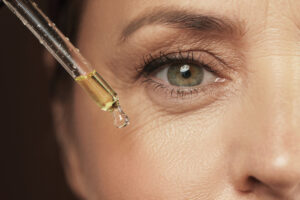As we age, things change. The environment around us, the people around us, our perspectives, and even our bodies. That’s a given. As you reach seniority, it’s important to know in which ways your body will change, so you can be prepared and nourish it as best as you can.
Today, we’re going to discuss how our skin changes as we age and how we can take care of it. Sometimes it might be hard to accept it, but your number one priority should be your health. At all times. So without further ado, let’s see how we can alleviate some of the things that happen to our bodies the more we advance in age:

Actinic keratosis
Ultraviolet light from the sun or other manmade sources, such as a tanning bed, might cause raised and crusty growths. You will probably have more than one. Most of them turn red as time goes by, but some could have a tan-like or pink shade.
You might want to check with your doctor if you notice them. If left untreated, they turn into cancer. The doctor could prescribe a cream, remove them with surgery, or even freeze or burn them off.
Seborrheic keratosis
These tan and brown spots could appear anywhere on your body, especially after you reach middle age. It’s also worth mentioning that you might have more than one. They are completely harmless, but they might look like pre-cancer growths or even skin cancer, so you might want to get your doctor to check them out.
The majority of people don’t need any kind of treatment, but the doctor could remove them if you don’t feel comfortable with them. Or, you can even ask your doctor to test for cancer.
Age spots
Also known as liver spots, these small and dark patches show up in places with lots of sun, such as your face, hands, and shoulders, but also in your arms. They are way more common if you are over 50, but you can easily get them if you are younger and you like spending a lot of time outside.
Even if you won’t need treatment for them, your doctor could still take a sample to rule out cancer. Nowadays, medicine is even more advanced, and you can lighten them with various bleaching products or even remove them altogether. To prevent them, it’s very important to use sunscreen and avoid sitting in the sun for too long.

Cherry angioma
These super small and red bumps and growths can easily show up anywhere on your body, even if they are way more common on or close to your chest, belly, and back. Even if they don’t hurt, they might bleed if they get hit or scraped. Generally, you can leave them alone, but your doctor could also remove them with a laser if you don’t like the way they look.
Skin tags
These super-small flaps of tissue are aesthetically unpleasant, as they hang from your skin by a kind of stalk. You will usually find them on your chest, back, neck, armpits, and even around your groin.
Even if they are not dangerous, they can easily get irritated if your clothes rub against them. If you find them bothersome, the doctor could easily cut them off, freeze them off, and even burn them off with a special electric current or laser.
Solar elastosis
Long-term sun damage can easily turn your skin yellow and even cause bumps and deep ridges. It generally affects people of all skin tones, but it’s much more obvious on light skin. As a general rule, the sun only affects the top layer of your skin.
However, tobacco smoke might also cause deeper damage. If you suffer from such a condition, it would be highly recommended to avoid smoking. Also, stay out of the sun, or at least do everything you can to protect yourself from it.
Varicose veins
Weakened blood vessels could start to swell, twist, or even bulge. They generally show up on your legs and feet. Even if they don’t pinpoint any serious issues, they can still be linked to inflamed veins that result in superficial blood clots.
Moreover, sometimes they ache. Your doctor could give you a pair of compression socks or even stockings to add additional pressure and help get rid of them. If that doesn’t work either, there’s another option: having a minor surgery.
Spider veins
These super-small bundles of broken blood vessels pop up on your legs, ankles, feet, and even your face. Some of the causes might include a backup of blood, hormone changes, and even injury. They generally don’t point to a more serious health issue, but they can still burn.
You might want to try tight compression stockings to squeeze on them. If that doesn’t help either, your doctor could suggest a minor but effective surgical procedure.
Itchy skin
As we get older, our skin gets drier, which also makes it itchy. If it lasts for longer than 2 weeks on your body, you might want to see your doctor. It might be a sign of something more serious, such as kidney disease, a lack of iron, thyroid problems, or even liver problems. The doctor might examine you and even take blood to establish the cause and what’s the best way to tackle it. If you’re dealing with itchy skin, here’s a good cream that might help you deal with that.
Leg ulcers
Blood flow problems definitely make room for injuries in your lower legs and feet. If bacteria get into the broken skin, the entire area can easily become infected. If you suffer from a health condition such as diabetes that makes it heal slower, you might even wind up with an open sore or even an ulcer.
The doctor will try to keep the wound clean. In most situations, you need to put pressure on the area. You might even need surgery in case the ulcers don’t go away.
Contact dermatitis
This extremely itchy and painful condition generally comes in two forms. First, there’s allergic dermatitis, which appears after you touch something such as a poison ivy leaf or even use a scented laundry product.
Or, it might be irritant dermatitis, which generally results from things that really bother your skin, such as moisture or chapped lips. As you advance in age, the condition might not even respond to normal treatments. Medicated creams that you would generally use for age-related skin issues could also cause a reaction.
Bruising
When small blood vessels close to the surface of your skin break, you get a bruise. The more you advance in age, your skin gets thinner and loses fat, which also makes you bruise more easily. Technically, there’s nothing to worry about, but it might be a sign of something a bit more serious.
Some blood-thinning medications might also cause bruises, so you definitely should mention this to your doctor if you’re taking any medication.
Wrinkles
Wrinkles are something we need to get used to as we age. However, you might be able to slow the process with good food, tons of sleep, and constant exercise. Also, try to protect yourself from the sun, and watch out for any strong soaps that might strip your natural oils from your skin. If you can, try not to smoke; it just makes them worse. Wrinkles aren’t technically bad for you, but people don’t like the way they look.
If you found this article useful, we also recommend reading: Melancholic About Your Own Childhood? Relive It With Your Grandkids



















